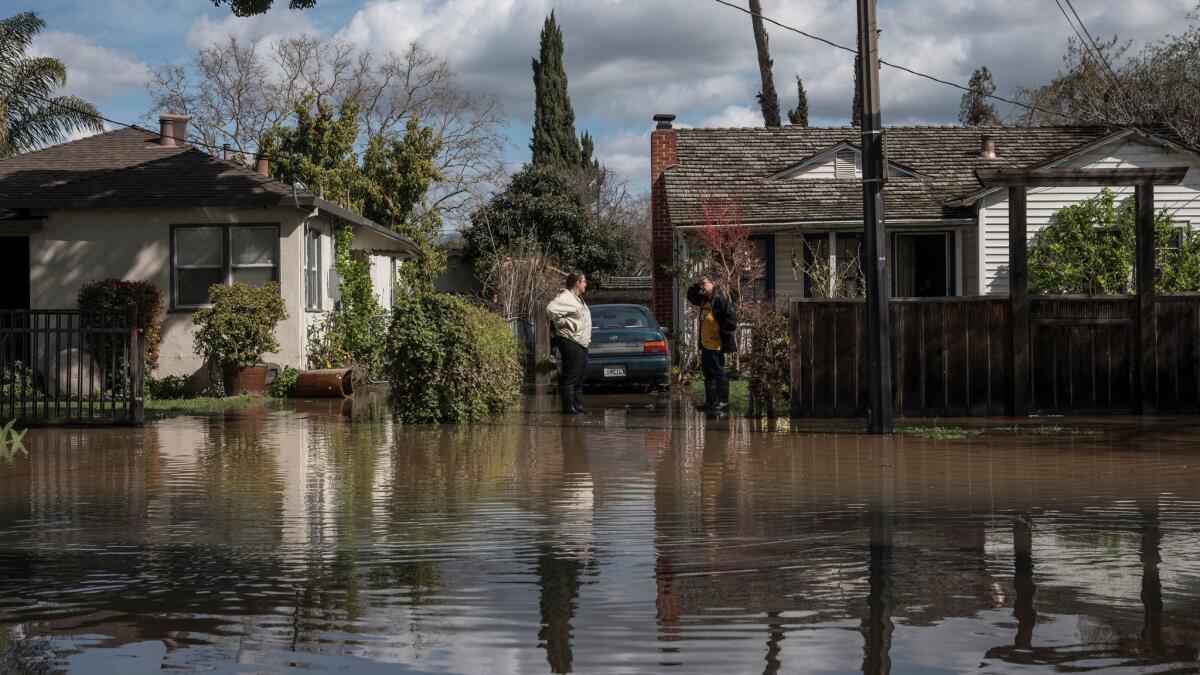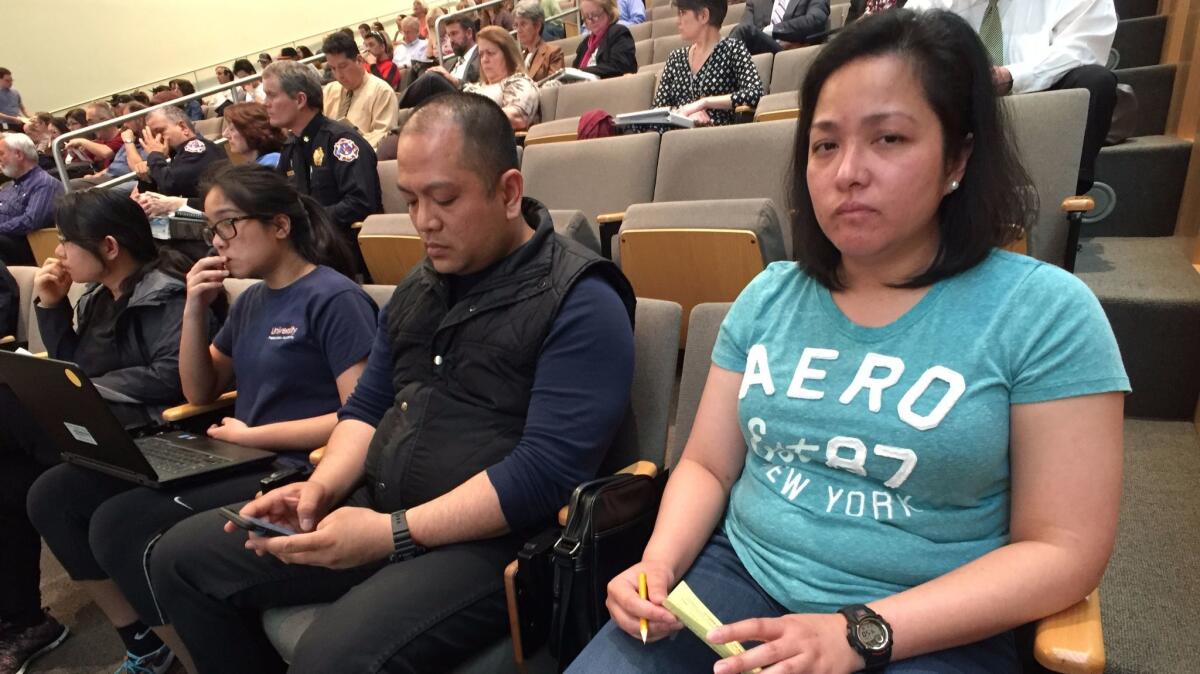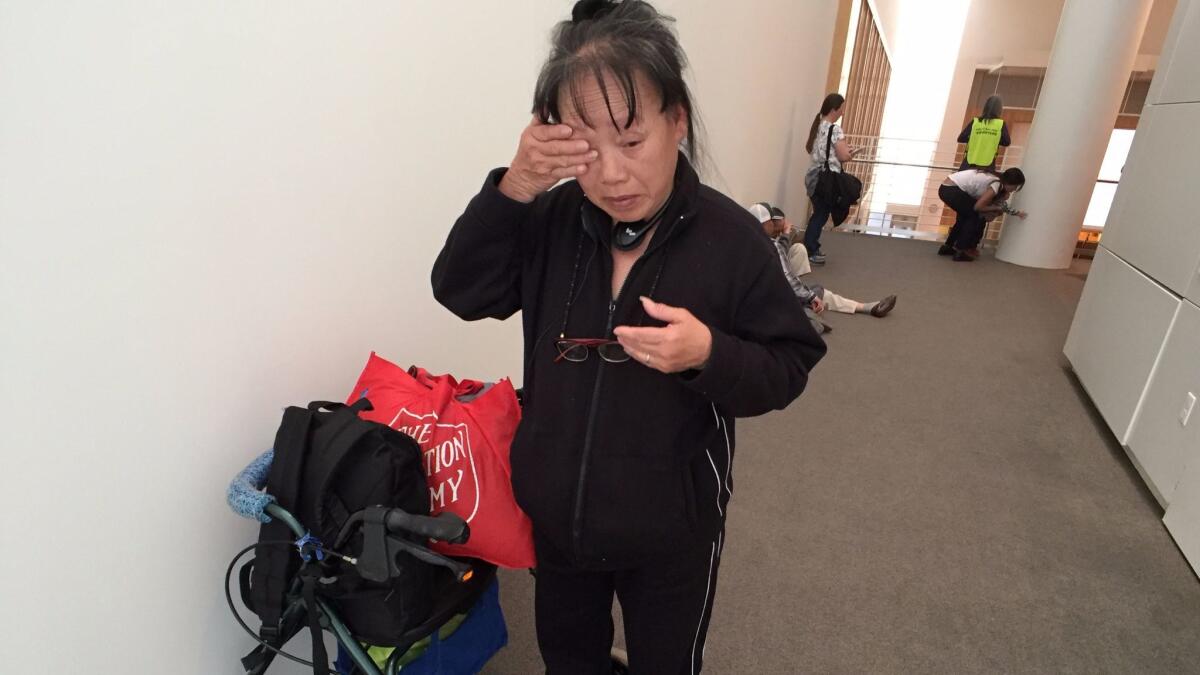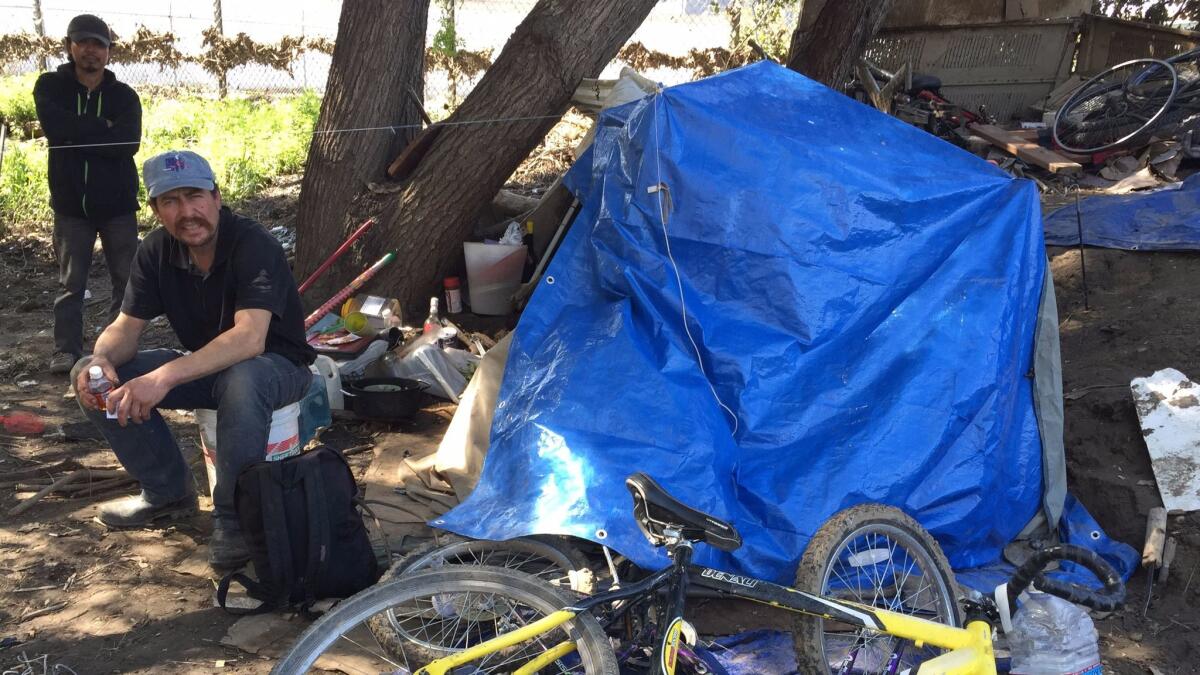California Journal: Struggling flood victims rip San Jose officials and ask why Apple, Google and Facebook haven’t helped

- Share via
Reporting from San Jose — One by one, for more than four hours, dozens of San Jose residents displaced by the city’s worst flooding in memory let city officials have it.
Remorseful city officials, who had given a presentation outlining their various failures, listened without interrupting.
“You had plenty of data to indicate that this storm could cause uncontrolled flooding of Coyote Creek,” said Bryan Rodriguez, 41, who owns a home in one of the worst-hit neighborhoods. “Yet you chose to do nothing to warn us. You need to prove to me that you are worth reelecting.”
“We need help,” said Erin Benavides, 23, who held her sleeping 15-month-old son, Josiah, as she wept. Her house was condemned, she said, and she has not been able to sleep or eat. Her 17-year-old sister has pneumonia, she said, and her son has been to the emergency room four times. “They gave us the dirtiest hotel. They just don’t care.”
“I’m a single woman. I’m old; I can’t help myself,” said Mong Van Fousek, a 70-year-old Vietnamese immigrant who collapsed in tears next to her walker. “I got no place to go. Please help us.”

“Please put down your phone and listen to me,” said Elvie Cledoro, 35, prompting a startled San Jose City Atty. Richard Doyle to look up from the semicircular dais, where he sat with San Jose Mayor Sam Liccardo, City Manager Norberto Duenas and members of the City Council.
Cledoro is consumed with anxiety and has not had a good night’s sleep in two weeks at the shelter she shares with her husband, teenage daughter and 100 or so other flood victims.

“Between the babies crying and the people snoring like a Harley Davidson, oh, my God,” she told me as she dabbed at her eyes. “Everybody talks about how much help we’re getting. It’s not enough.”
::
Californians pretty much live with the knowledge that the Big One will hit without warning. But we do not expect to be taken unawares by flooding.
If a dam fills and its spillway fails — as happened last month in Oroville — we have faith that our officials will alert us to danger. Someone will call, text, rap at the door, drive by with a loudspeaker: Time to get out. If we fail to heed the warnings, like the stubborn homeowner on his roof fighting a conflagration with a garden hose, that’s on us.
What happened on Coyote Creek in San Jose on Feb. 21 was an inexcusable human failure.
“Where were you?” Mary Hegland, 73, a Santa Clara University anthropology professor, demanded to know Thursday. “There was no warning that our streets were going to turn into raging rivers. I would be so ashamed if I worked for the city.”
Indeed, the city has admitted that it did not have a proper emergency warning system in place, nor anything tailored for the many Vietnamese- and Spanish-speaking residents of the three flooded neighborhoods.
“We empathize and acknowledge the suffering of our residents,” Duenas said. “And for that, I am truly and deeply sorry.”
Blame also falls squarely on Santa Clara Valley Water District officials, who are responsible for flood control. They severely overestimated how much water could safely spill into Coyote Creek from nearby Anderson Dam, swollen to more than 100% of its capacity by heavy rains.
Coyote Creek was supposed to be able to handle a flow of 7,400 cubic feet of water per second as it passed Rock Springs, the hardest-hit neighborhood. But flooding occurred at 4,000 cubic feet per second.
Residents going about their business the morning of Feb. 21 did not realize they were in danger until water breached their homes. At some points, the water was 5 feet deep. Hundreds of people were rescued by boat. Fortunately, there were no serious injuries or deaths.
The city and the water district have begun to tangle over blame: Was it the city’s responsibility to clear debris from the stretches of Coyote Creek that it owns? Why did the water district not realize its flood projections were flawed?
The city estimated the flood damage at $73 million and is seeking aid from the state and federal government.
A Vietnamese American billionaire from Los Angeles County, Kieu Hoang, gave $5 million to relief efforts, bringing the donation total to about $6.25 million.
More than one resident wondered why Apple, Google and Facebook hadn’t pitched in. (Donations have come from most of the local professional sports teams, auto dealers, Kaiser Permanente, labor unions, Chipotle, Wells Fargo, Safeway and Comcast, among others.)
“It would seem a natural and welcome opportunity for the big tech firms to support people in serious need in their home base,” San Jose spokesman David Vossbrink told me.
No kidding. I emailed the three tech behemoths late Friday. A Facebook spokesman said the company considers its contribution to be the digital tools that allow people to connect during disasters. The other two did not respond.
As of Thursday, Sacred Heart Community Service had disbursed $802,000 of the donations, handing out $3,000 checks to qualified residents. Sounds like a lot, but when you are unable to work, or you’ve lost your car and your apartment, and your landlord is continuing to charge rent, it goes pretty fast.
But some have fallen through the cracks. Consuelo Nelson, a 56-year-old Uber driver, told the council that she was denied a check because she rents an unpermitted guest house that does not have its own address, and her landlady had already received a check.
And then, of course, there are the scores of homeless people who make their home along the banks of Coyote Creek.
“Do the homeless get $3,000?” asked Gail Osmer, a homeless advocate. “What about hot meals?”
::
Thursday afternoon, before the council meeting, I drove over to the Rock Springs neighborhood, southeast of downtown. I parked behind some town homes, then walked down to Coyote Creek.
The muddy river was still moving fast. A gray plastic garbage can was stuck in tree branches about 10 feet above the water line, deposited there by high waters.

I bumped into Jose Sosa, a 47-year-old homeless day laborer, who usually stays on the riverbank. He sat on a five-gallon plastic bucket next to a blue tarp pitched like a tent. He showed me a spot on the creek bank where he’d planted 15 saplings. Most had washed away.
The day of the flood, he woke at 5:30 a.m. with water lapping at his bed. “I said to my friend, ‘We better go,’ ” he said. “We lost everything.”
Sosa returned once the water receded, but he isn’t sure it’s safe because rainy season isn’t over. He may move to a shelter, or perhaps try to rent a room if he can scrape together the cash. No one’s handing out big checks to people like him. For the chronically homeless, invisibility is a way of life.
But for the newly homeless, displaced by disaster, the challenge is staying visible in the shadow of Silicon Valley’s preposterous wealth.
Twitter: @AbcarianLAT
ALSO
A proposed California license plate is a subtle nod to abortion rights and to a slain hero
In the Central Valley, drought fears ease, but farmers contend with a new threat: Trump
Appalled California press secretaries from both parties try to explain Sean Spicer
UPDATES:
6:10 p.m., March 13: This article was updated with the damage estimate from the flood.
This article was originally published at 11:30 a.m. on March 11.







